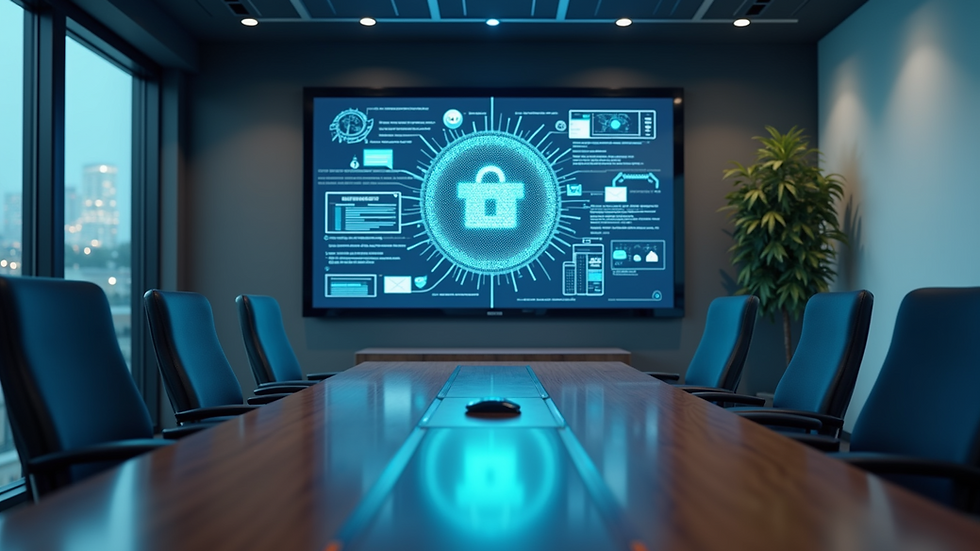Developing Cybersecurity Leadership Skills for the Future
- ariel2016
- Nov 4
- 4 min read
In today’s rapidly evolving digital landscape, the role of cybersecurity leaders has never been more critical. As cyber threats grow in complexity and frequency, organizations must rely on skilled leaders who can navigate these challenges effectively. Developing cybersecurity leadership skills is essential not only for managing risks but also for fostering innovation and resilience. This post explores practical strategies and insights to help you build strong cybersecurity leadership capabilities that will serve you well into the future.
Understanding the Importance of Cybersecurity Leadership Development
Cybersecurity leadership development is more than just acquiring technical knowledge. It involves cultivating a mindset that balances risk management, strategic thinking, and team empowerment. Leaders in this field must understand the broader business context while staying ahead of emerging threats.
Why focus on leadership development? Because cybersecurity is no longer just an IT issue. It impacts every aspect of an organization, from reputation to regulatory compliance. Effective leaders can:
Align cybersecurity initiatives with business goals
Communicate risks clearly to stakeholders
Inspire and guide teams through crises
Drive continuous improvement in security posture
For example, a cybersecurity leader who understands the financial implications of a data breach can better advocate for necessary investments in security tools and training. This holistic approach ensures that cybersecurity is integrated into the organization’s DNA.

Key Competencies in Cybersecurity Leadership Development
To develop as a cybersecurity leader, focus on building these core competencies:
1. Strategic Vision and Business Acumen
A strong leader sees beyond the technical details. You need to understand how cybersecurity fits into the organization’s overall strategy. This means learning about business operations, financial metrics, and regulatory environments. For instance, knowing how GDPR or CCPA affects your company helps you prioritize compliance efforts effectively.
2. Communication and Influence
Cybersecurity leaders must translate complex technical concepts into clear, actionable information for executives, board members, and employees. This skill builds trust and ensures everyone understands their role in maintaining security. Practice storytelling techniques and tailor your message to different audiences.
3. Risk Management and Decision-Making
Effective leaders assess risks realistically and make informed decisions under pressure. This involves balancing security needs with operational efficiency. Use frameworks like NIST or ISO 27001 to guide your risk assessments and mitigation plans.
4. Team Building and Talent Development
Your team is your greatest asset. Invest time in mentoring, coaching, and creating a culture of continuous learning. Encourage collaboration and diversity to bring fresh perspectives to problem-solving.
5. Adaptability and Continuous Learning
The cybersecurity landscape changes rapidly. Stay current with emerging threats, technologies, and best practices. Attend conferences, participate in training programs, and engage with professional communities.
By focusing on these competencies, you position yourself to lead effectively in a complex and dynamic environment.
Practical Steps to Enhance Your Cybersecurity Leadership Skills
Developing leadership skills requires deliberate effort and practical experience. Here are actionable recommendations to accelerate your growth:
Enroll in Cybersecurity Leadership Training
Formal training programs provide structured learning and exposure to real-world scenarios. For example, cybersecurity leadership training offers courses designed to bridge the gap between technical expertise and executive leadership. These programs often include case studies, simulations, and mentorship opportunities.
Seek Cross-Functional Experience
Work closely with departments like legal, compliance, and finance to understand their perspectives on cybersecurity. This collaboration enhances your ability to align security initiatives with broader organizational goals.
Lead Incident Response Exercises
Participate in or lead tabletop exercises and simulations. These activities sharpen your crisis management skills and improve team coordination during actual incidents.
Build a Personal Learning Network
Connect with other cybersecurity professionals through forums, social media, and industry groups. Sharing knowledge and experiences helps you stay informed and inspired.
Develop Emotional Intelligence
Strong leaders manage their emotions and understand others’ feelings. This skill improves communication, conflict resolution, and team morale. Practice active listening and empathy in your daily interactions.

The Role of Technology and AI in Future Cybersecurity Leadership
Technology continues to reshape the cybersecurity landscape. Leaders must understand how to leverage tools like artificial intelligence (AI), machine learning, and automation to enhance security operations.
AI can help detect anomalies, predict threats, and automate routine tasks, freeing up your team to focus on strategic initiatives. However, it also introduces new risks, such as adversarial attacks on AI models. As a leader, you must balance innovation with caution.
Investing in AI governance education is crucial. Leaders should establish policies that ensure ethical AI use and compliance with regulations. This proactive approach builds trust and accountability.
Moreover, understanding emerging technologies enables you to anticipate future challenges and opportunities. For example, quantum computing may disrupt current encryption methods, requiring new strategies for data protection.
Building a Resilient Cybersecurity Culture
Leadership is not just about policies and technology; it’s about people. Creating a resilient cybersecurity culture is fundamental to long-term success.
Promote Awareness and Accountability
Regular training and awareness campaigns help employees recognize threats like phishing and social engineering. Encourage a culture where everyone feels responsible for security.
Foster Open Communication
Create channels where team members can report incidents or concerns without fear of blame. Transparency leads to faster detection and resolution of issues.
Recognize and Reward Good Practices
Celebrate successes and acknowledge individuals who contribute to security improvements. Positive reinforcement motivates continued vigilance.
Integrate Security into Daily Operations
Make cybersecurity a natural part of workflows rather than an afterthought. This integration reduces friction and increases compliance.
By embedding these principles into your organization, you build a strong foundation that supports your leadership efforts.
Preparing for the Challenges Ahead
The future of cybersecurity leadership will demand agility, foresight, and collaboration. As threats evolve, so must your skills and strategies.
Stay informed about global cyber trends and geopolitical factors influencing security.
Advocate for investment in talent development and advanced technologies.
Embrace diversity and inclusion to foster innovation and resilience.
Lead with integrity and a commitment to ethical practices.
By adopting these approaches, you will not only protect your organization but also contribute to shaping the future of cybersecurity leadership.
Developing cybersecurity leadership skills is a continuous journey. It requires dedication, learning, and a willingness to adapt. By focusing on strategic vision, communication, risk management, and culture-building, you can position yourself as a leader ready to face the challenges of tomorrow. Investing in your growth today will pay dividends in resilience and success for years to come.




Comments